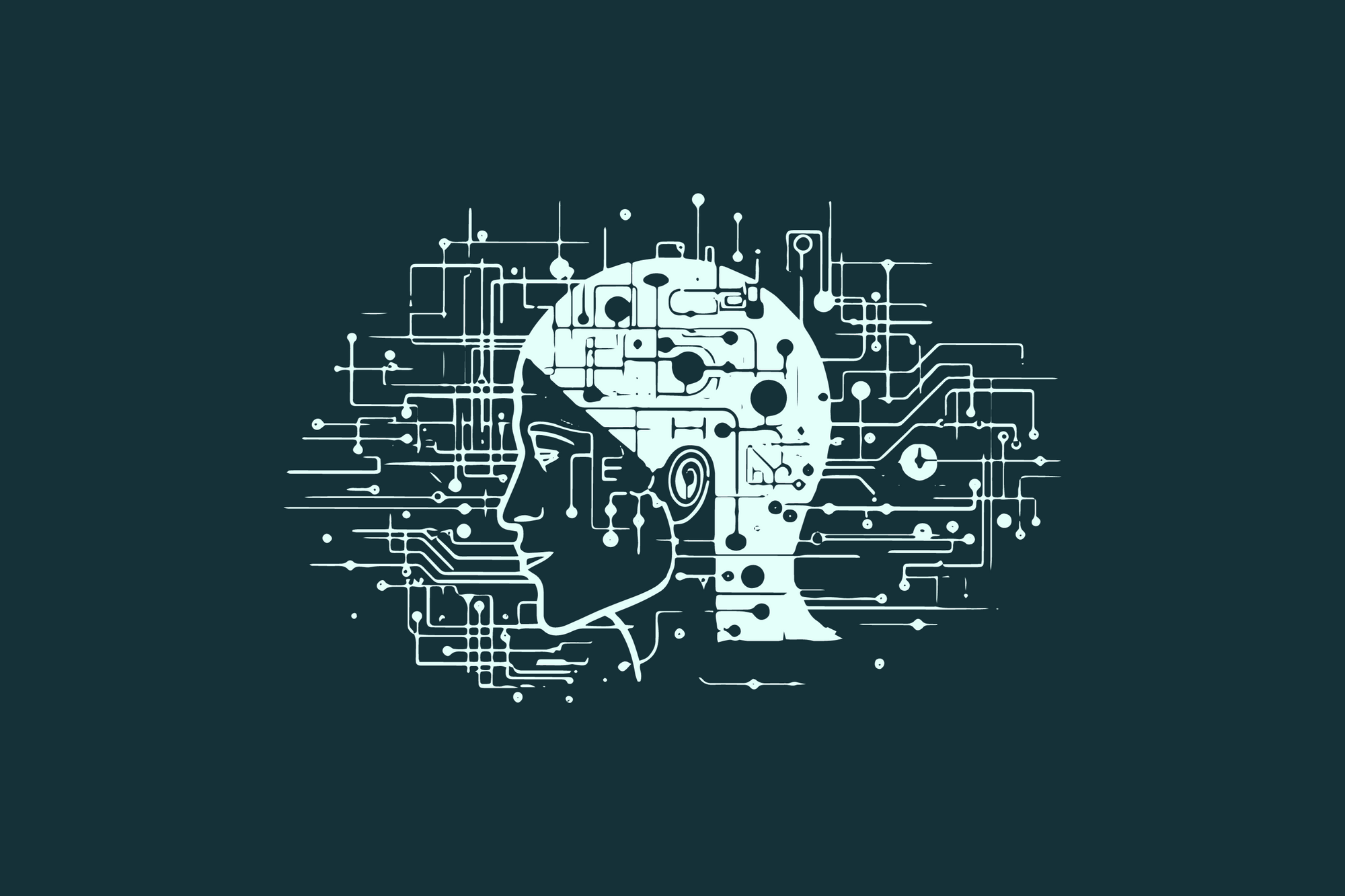Contents
In the ever-evolving landscape of the fashion industry, the integration of Artificial Intelligence (AI) has emerged as a transformative force, reshaping the traditional paradigms of product development.
This synergy of technology and fashion has given rise to a new era, where data-driven insights, predictive analytics, and innovative applications of AI are revolutionizing the way garments are conceived, designed, and brought to market.
In this exploration, we delve into the profound impact of Artificial Intelligence on fashion product development, uncovering the myriad ways in which cutting-edge technologies are not just influencing, but fundamentally reshaping the creative and logistical aspects of an industry that thrives on innovation and trends.
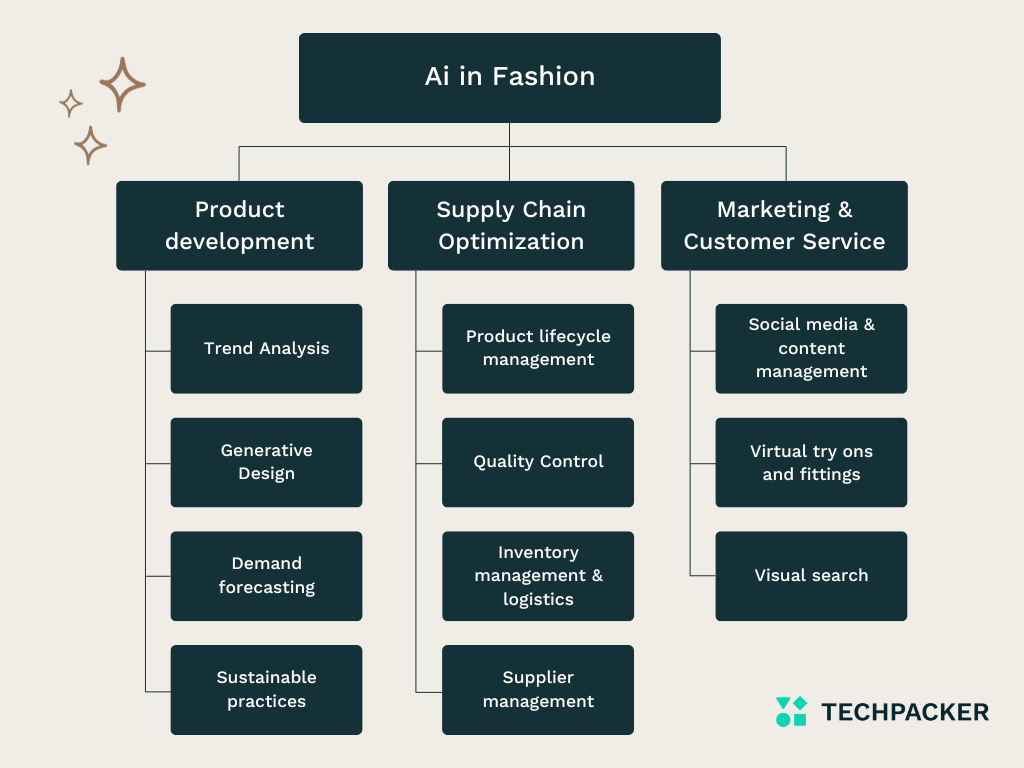
Product design assistance
Artificial Intelligence (AI) is revolutionizing product development across various industries by offering innovative solutions and augmenting traditional processes. In essence, the integration of AI into product development empowers businesses to make more informed decisions, streamline operations, and deliver products that are not only innovative but also aligned with market demands.
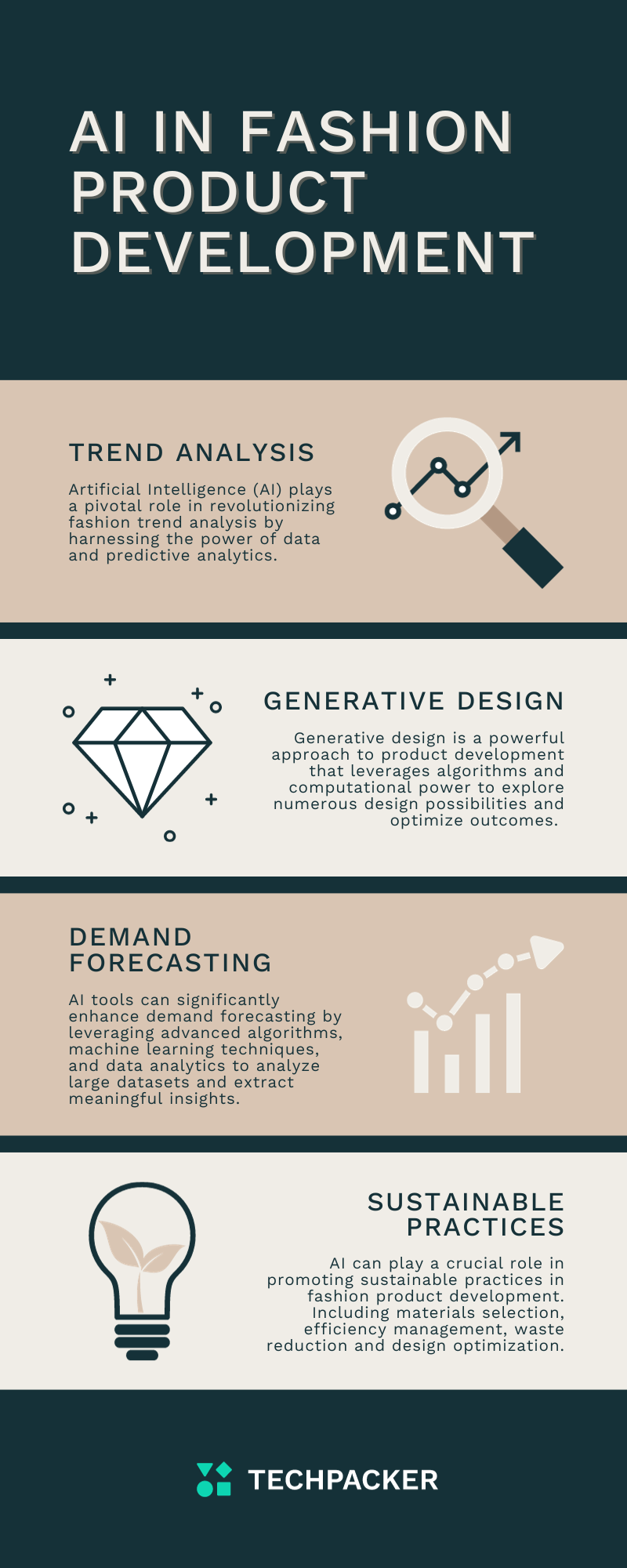
Trend analysis
Trend analysis in product development involves the systematic examination and evaluation of current and emerging trends in the fashion industry. It is a strategic process that helps fashion designers, brands, and retailers make informed decisions about the design, production, and marketing of their products.
The goal of trend analysis is to stay relevant in the ever-changing market by aligning products with consumer preferences and style movements.
Artificial Intelligence (AI) plays a pivotal role in revolutionizing fashion trend analysis by harnessing the power of data and predictive analytics. Here are ways in which AI contributes to and enhances the process of fashion trend analysis:
- Data Mining and Collection. AI systems can efficiently gather and analyze vast amounts of data from various sources, including social media, fashion blogs, online publications, and e-commerce platforms. This data includes information on consumer preferences, style choices, and emerging trends.
- Pattern Recognition. AI utilizes advanced pattern recognition algorithms to identify recurring themes, colors, styles, and motifs across diverse datasets. This helps in spotting emerging trends and understanding the evolution of fashion preferences.
- Real-time Monitoring. AI enables real-time monitoring of social media platforms and fashion-related websites. By tracking hashtags, mentions, and engagement metrics, AI systems can provide instant insights into which trends are gaining traction and popularity.
- Predictive Analytics. AI algorithms use historical data to predict future trends, forecasting what styles, colors, or designs are likely to be in demand. This assists designers and retailers in making proactive decisions about inventory and product development.
- Consumer Behavior Analysis. AI analyzes consumer behavior, preferences, and purchasing patterns to understand the factors influencing fashion choices. This information aids in tailoring marketing strategies and product offerings to better align with customer expectations.
- Market Segmentation. AI helps in segmenting the market based on demographics, geography, and other relevant factors. This segmentation allows for a more nuanced understanding of regional or niche trends, ensuring that fashion products are tailored to specific target audiences.
- Competitor Analysis. AI assists in monitoring and analyzing the strategies of competitors in the fashion industry. By understanding what is successful in the market, businesses can adapt their approaches to stay competitive.
Let’s review some of the AI trend analysis technologies.
Brandwatch‘s suite features a consumer research solution with an AI tool that can generate insights from 15 years’ worth of data. Its dataset dates back to 2008 and includes over 100 million web sources and over 1.4 trillion social media postings. Subscribers may also view up to 500 new posts in real-time every day.
Blue Silk AI, the Talkwalker platform's heart, is made up of two programs that track trending content: Insight and 1-Click AI classifier. From hundreds of customer reviews, polls, and emails, the Insight function identifies and gathers customer service difficulties, delivery issues, product flaws, and other consumer opinions. All of this feedback is processed and summarized by the AI algorithm in a few phrases. Meanwhile, the 1-Click Classifier allows you to use short descriptions of subjects to classify social discussions, articles, and blogs, as well as filter for relevant consumer data.
In terms of linking diverse data sources and applying analytics to information, Power BI works well with Microsoft spreadsheet tools. Connectors combine data from sources other than Excel files, such as your CRM system, and third-party services like Google Analytics, SAP, Salesforce, Twilio, and Marketo.
Generative design
A branch of AI known as generative AI focuses on teaching robots to create original and innovative material. Unlike traditional AI, which functions according to preset rules, generative AI may learn from data and develop content on its own. This technology uses complicated algorithms and neural networks to identify patterns and generate outputs that are similar to human ingenuity.
Generative design is a powerful approach to product development that leverages algorithms and computational power to explore numerous design possibilities and optimize outcomes.
Generative design enhances product development by providing designers with a powerful tool to explore, optimize, and innovate in the early stages of the design process. It accelerates the generation of high-quality designs, promotes efficiency, and enables the creation of products that are both functional and aesthetically pleasing.
Here's how generative design helps in product development:
- Exploration of Design Space. Generative design algorithms can rapidly explore a vast design space, considering a wide range of parameters and constraints. This enables designers to consider innovative solutions and uncover design possibilities that may not be immediately apparent through traditional methods.
- Optimization of Designs. Generative design aims to optimize designs based on specific criteria, such as weight reduction, structural integrity, or material usage. The algorithms can iteratively refine designs to meet performance goals, resulting in more efficient and effective products.
- Time and Cost Efficiency. By automating the design exploration process, generative design saves time and reduces the need for manual iterations. This efficiency is particularly valuable in industries with tight deadlines and cost constraints.
- Iterative Feedback Loop. Generative design allows for a continuous feedback loop between the algorithm and the designer. Designers can input their preferences and constraints, and the algorithm refines the designs accordingly. This iterative process helps in achieving the desired outcomes.
Repsketch, for example, is an online vector editing software that generates realistic graphics from your flat sketches. It allows you to change the background, add branding information, material specifications, and so forth. Such realistic visuals can give your fashion team a preview of a final product before manufacturing an actual physical sample, and they can be updated quickly, reducing the number of iterations throughout the sample creation process dramatically. Images generated by AI may also be utilized for presentations and sneak peeks for potential customers.
Artiphoria is another example of using Generative Ai to create digital artworks. It allows users without graphic design skills to make graphics with a single click. It is an excellent tool for creating artwork that will be printed on garments and accessories.
Vmake, on the other hand, is an AI-powered photo and video editing application that allows users to create backdrops and improve photographs and videos for marketing and content development.
Demand forecasting
Demand forecasting is a systematic process of estimating the future demand for a product or service. It involves analyzing historical data, market trends, and other relevant factors to make predictions about the quantity of goods or services that consumers will likely purchase in the future. The primary goal of demand forecasting is to help businesses make informed decisions regarding production, inventory management, and overall supply chain planning.
AI tools can significantly enhance demand forecasting by leveraging advanced algorithms, machine learning techniques, and data analytics to analyze large datasets and extract meaningful insights. Here are some ways in which AI tools can contribute to more accurate and efficient demand forecasting:
- Pattern Recognition: AI tools can identify complex patterns and relationships within historical sales data, enabling more accurate predictions of future demand. This is particularly valuable in scenarios where traditional statistical methods may struggle to capture non-linear or dynamic patterns.
- Predictive Analytics: AI tools can perform predictive analytics by analyzing various factors that influence demand, such as seasonality, market trends, economic indicators, and external events. This allows for a more comprehensive and dynamic understanding of the factors affecting demand.
- Real-time Data Processing: AI tools can process and analyze real-time data streams, providing up-to-the-minute insights into changing market conditions and consumer behavior. This agility is particularly crucial in fast-paced industries where demand patterns can evolve rapidly.
Stylumia deploys its AI and machine learning platform to help fashion and lifestyle brands forecast demand, spot trends, manage inventory, and make better business decisions.
Heuritech analyzes millions of images to give their customers quantitative data on the evolution of the consumer’s preferences. Using their platform brands can analyze the predicted visibility growth of shapes, colors, prints, and fabrics, and their forecast market share.
Sustainable practices
AI can play a crucial role in promoting sustainable practices in fashion product development. Here are several ways in which AI can contribute to sustainability efforts:
- Materials Selection. AI algorithms can analyze and recommend sustainable materials for product development by considering factors such as renewable resources, recyclability, and environmental impact. This can lead to the use of materials with lower carbon footprints or reduced ecological consequences.
- Energy Efficiency. AI can optimize energy consumption in manufacturing processes and facilities. By analyzing real-time data and making adjustments, AI helps reduce energy waste and lower greenhouse gas emissions associated with production.
- Waste Reduction. AI can be applied to minimize waste in production processes by optimizing resource utilization, predicting defects, and improving quality control. This reduces the environmental impact and lowers costs associated with waste disposal.
- Design Optimization. AI-driven generative design can assist engineers in creating more efficient and lightweight product designs. This can lead to the development of products that require fewer raw materials and energy during manufacturing, transportation, and use.
Green Story uses data analytics to cut down on fashion waste. By using their platform fashion brands can gain access to accurate, credible, and verifiable sustainability data. Green Story is also using data to track product usage and reduce premature disposal. The business has created a new app that lets users keep track of how frequently they wear their clothes. The app also offers advice on how to prolong the life of clothing through proper maintenance. Green Story's data-driven approach to sustainability is fostering a more circular fashion industry and lowering waste.
AutoDraw is a web-based drawing application driven by artificial intelligence. It was built by Dan Motzenbecker and Kyle Phillips of Google Creative Lab to make drawing accessible and entertaining for everyone. It enables you to sketch quickly and develop your artwork by combining machine learning with drawings by diverse artists.
Simply scribble something with AutoDraw. Its suggestion tool will then make an educated estimate as to what you're sketching. Then it will propose drawing recommendations produced by many artists and designers to improve the appearance of your artwork.
Product lifecycle and supply chain management
AI tools can significantly contribute to supply chain optimization by providing advanced analytics, predictive capabilities, and automation. AI tools help organizations optimize their supply chains, improve efficiency, reduce costs, and enhance overall responsiveness to market dynamics. Successful implementation often involves integrating AI with existing systems and processes, as well as fostering a culture of data-driven decision-making within the organization.
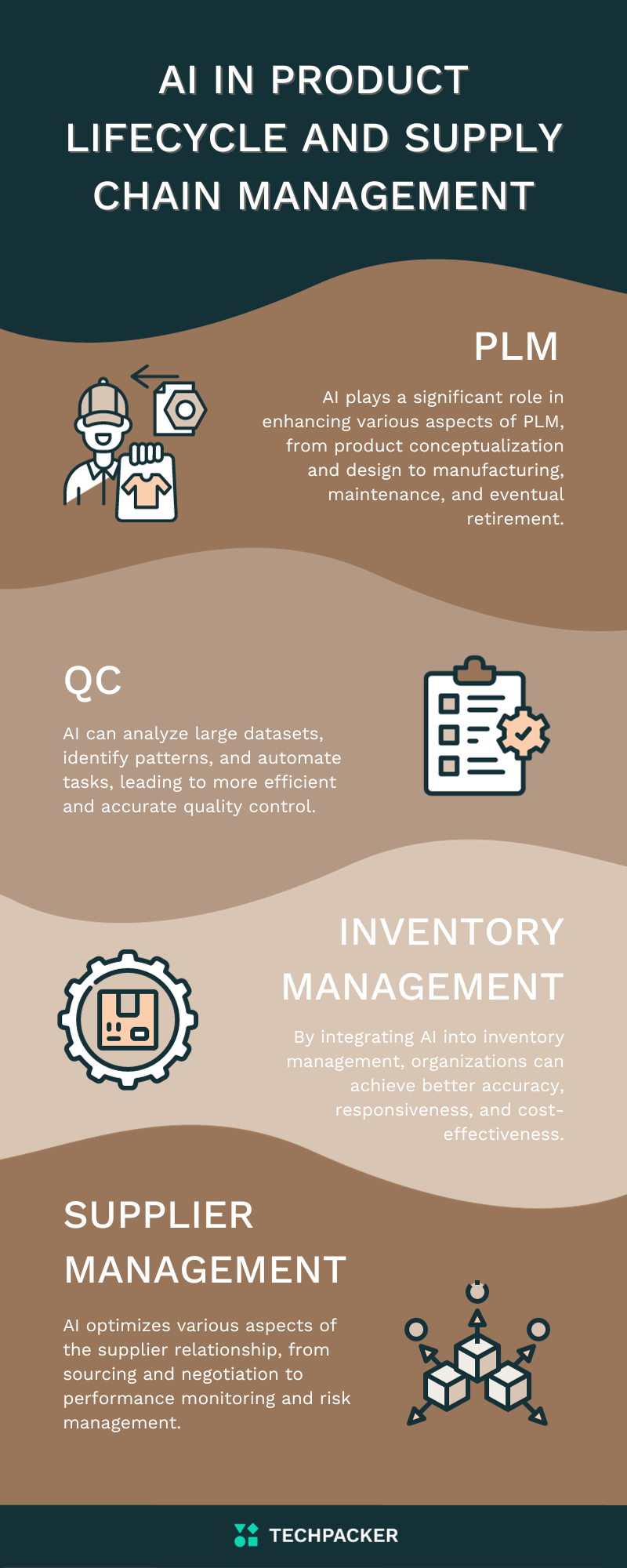
Product lifecycle management
Product Lifecycle Management (PLM) is a systematic process for managing the entire lifecycle of a product from its initial concept and design, through manufacturing and use, to its eventual disposal or retirement.
Artificial Intelligence (AI) can play a significant role in enhancing various aspects of Product Lifecycle Management (PLM), from product conceptualization and design to manufacturing, maintenance, and eventual retirement. Here are several ways AI can contribute to PLM:
- Collaborative Product Development. AI-powered NLP tools can facilitate communication and collaboration among cross-functional teams involved in product development. This includes improving documentation, requirements management, and communication within the PLM system.
- Supply chain integration. AI helps assess supplier performance, identify potential risks, and optimize supplier relationships, ensuring a smooth flow of materials and components.
- Predictive Analytics. AI can analyze historical data and real-time sensor data from products to predict when maintenance is required. This leads to more efficient maintenance planning, minimizing downtime, and extending the lifespan of products.
PLM software is being used by many fashion firms across the world to increase visibility and data flow throughout their company and the whole supply chain.
Techpacker PLM software is a data management system that maintains data throughout the product development process, from idea to manufacture. Its primary goal is to provide a central location for managing the product lifecycle efficiently and cost-effectively. Techpacker contains all essential PLM features including rapid design tools, integrations, component libraries, reporting, communication, and custom sections. Its specialized manufacturers' hub, which is used by factories all over the world, provides a platform for brands to easily onboard their chosen vendors.
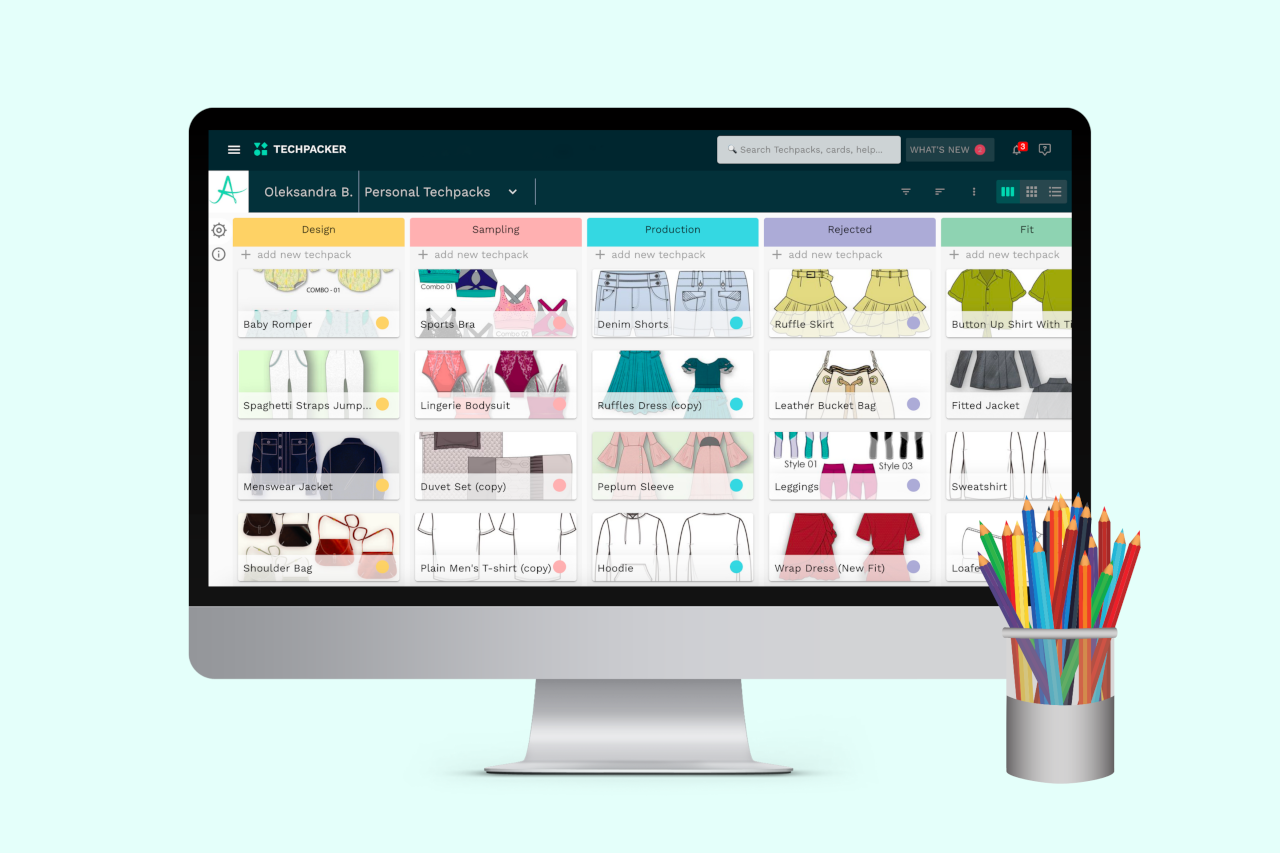
Logility enables brands to sense and adapt to shifting market conditions, allowing them to run their complex worldwide enterprises more profitably. The Logility® Digital Supply Chain Platform uses a novel combination of artificial intelligence (AI) and sophisticated analytics to automate planning, reduce cycle times, boost accuracy, improve operating performance, break down company silos, and provide better visibility.
Quality control
Quality control in fashion product development refers to the systematic process of ensuring that the products being developed meet predefined standards and specifications. It is a critical aspect of the entire product lifecycle, starting from the design and prototyping stage to manufacturing, distribution, and ultimately reaching the end consumers. The goal of quality control is to deliver products that meet or exceed customer expectations in terms of design, craftsmanship, durability, and overall performance.
By leveraging advanced algorithms and machine learning techniques, AI can analyze large datasets, identify patterns, and automate tasks, leading to more efficient and accurate quality control. Here are several ways in which AI tools can contribute to quality control:
- Automated Inspection. AI-powered computer vision systems can automatically inspect and analyze visual aspects of products. This includes identifying defects, irregularities, or variations in color, stitching, and overall workmanship. Automated inspection reduces the reliance on manual labor, speeds up the process, and provides consistent results.
- Quality Analytics. AI-driven analytics can analyze data from various sources, including production processes, inspection results, and customer feedback. This provides insights into overall product quality, allowing organizations to make data-driven decisions for continuous improvement.
- Supplier Quality Management. AI can assist in assessing and managing the quality of components and materials provided by suppliers. By analyzing supplier performance data, AI tools help organizations make informed sourcing decisions and ensure that materials meet quality standards.
- Automated Documentation and Reporting. AI can automate the documentation of quality control processes and generate comprehensive reports. This not only improves efficiency but also provides a detailed record of quality control activities for audit and compliance purposes.
Advantive is software that helps to maximize product quality, reduce manufacturing costs, and discover production difficulties immediately. This cutting-edge SPC-based software can assist firms in improving quality operations. Advantive's visual models, such as control charts and dashboards, simplify quality control and aid in the faster identification of underlying causes. Team members may monitor quality control procedures from any device and implement cost-cutting initiatives immediately.
Techpacker PLM software lets you create a range of visual reports with a single click. Time and action reports, as well as Gantt charts, are included. Brands can perform in-house quality control, request modifications quickly, and never miss a manufacturing error by capturing fit remarks and points of measurement with Techpacker's Fit Sheets.
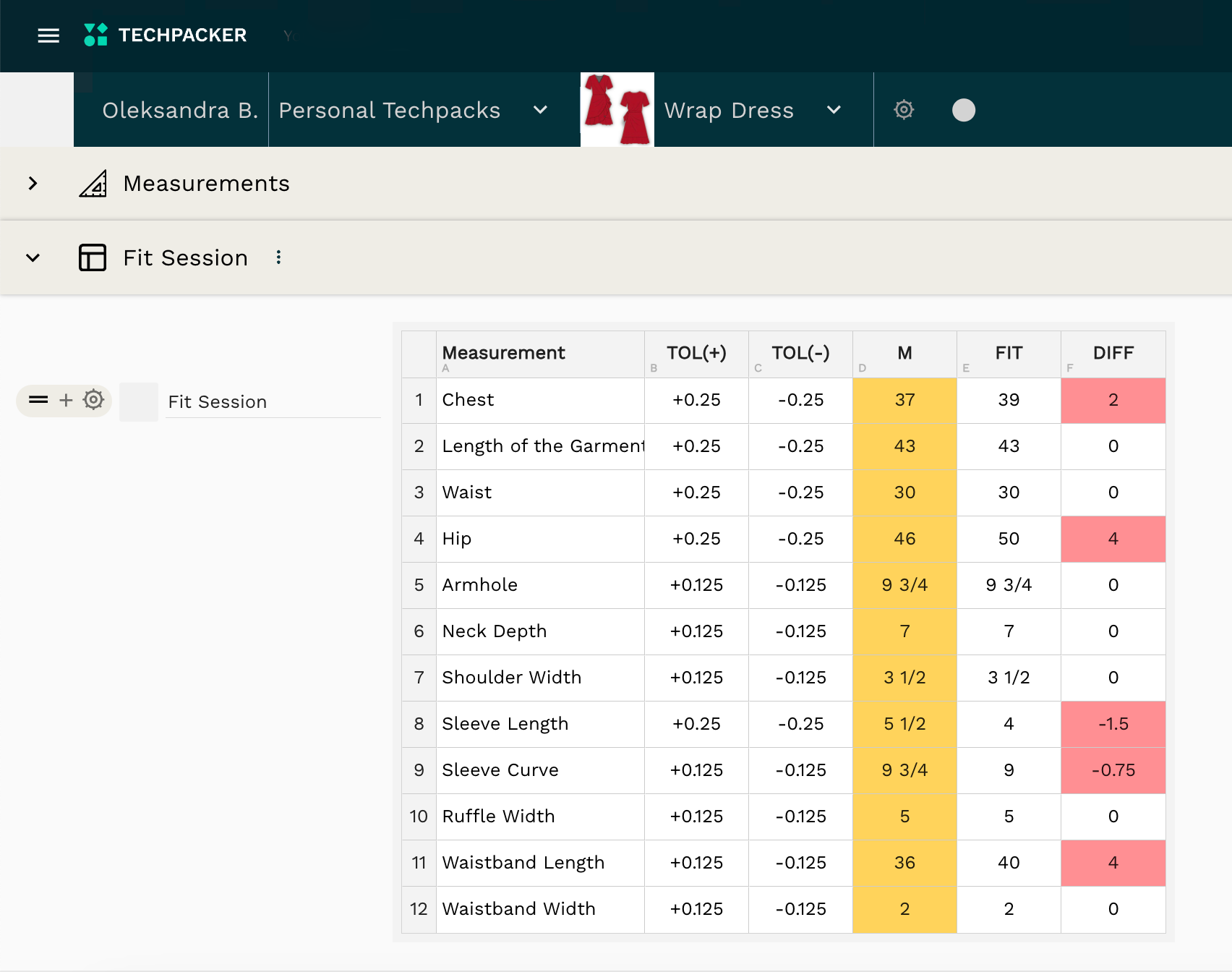
Inventory management and logistics
AI can play a crucial role in optimizing inventory management and logistics by leveraging advanced algorithms and machine learning capabilities. By integrating AI into inventory management and logistics processes, organizations can achieve better accuracy, responsiveness, and cost-effectiveness. Implementing AI solutions often involves collaboration across different departments and the integration of AI tools with existing systems to create a more intelligent and adaptive supply chain.
Here are several ways in which AI can help enhance efficiency and accuracy in these areas:
- Demand Forecasting. AI algorithms can analyze historical sales data, market trends, and external factors to generate accurate demand forecasts. This helps organizations plan and optimize inventory levels, reducing the risk of stockouts or overstock situations.
- Dynamic Replenishment. AI-powered systems can dynamically adjust reorder points and quantities based on real-time demand fluctuations. This ensures that inventory levels remain optimal, responding to changes in market demand and preventing excess stock or stockouts.
- Predictive Analytics for Lead Times. AI can predict lead times for suppliers and logistics providers by analyzing historical data and external factors. This information helps organizations plan for timely inventory replenishment and optimize the flow of goods through the supply chain.
- Route Optimization. AI algorithms can optimize logistics routes by considering factors such as traffic conditions, delivery schedules, and transportation costs. This improves the efficiency of product distribution, reduces transportation expenses, and enhances overall logistics performance.
- Real-time Visibility. AI tools provide real-time visibility into inventory levels and logistics operations. This transparency allows organizations to track the movement of goods, monitor inventory in transit, and respond promptly to any disruptions or delays.
- Warehouse Automation. AI-powered robotics and automation systems can streamline warehouse operations. This includes automated picking and packing processes, inventory tracking using drones or robots, and overall warehouse optimization to reduce labor costs and improve efficiency.
- Smart Inventory Allocation. AI can analyze demand patterns and customer behavior to optimize inventory allocation across different locations. This ensures that products are strategically positioned to meet regional demand, reducing shipping costs and delivery times.
- Supplier Performance Monitoring. AI helps in monitoring and analyzing supplier performance data. This includes assessing the reliability of suppliers, analyzing delivery times, and identifying potential risks in the supply chain. This information aids in making informed decisions about supplier relationships.
- Optimized Last-Mile Delivery. AI algorithms can optimize last-mile delivery processes by considering factors such as delivery routes, traffic conditions, and customer preferences. This results in more efficient and timely deliveries, enhancing customer satisfaction.
- Reverse Logistics Optimization. AI can optimize reverse logistics processes, which involve handling product returns and exchanges. By analyzing return patterns and reasons for returns, organizations can improve return management strategies and reduce associated costs.
- Predictive Maintenance for Vehicles. AI can predict maintenance needs for logistics vehicles by analyzing sensor data. Predictive maintenance helps organizations schedule maintenance activities proactively, minimizing downtime and ensuring the reliability of the transportation fleet.
- Climate Control and Monitoring. In industries where temperature control is critical (e.g., pharmaceuticals, food), AI can monitor and control climate conditions during transportation and storage to ensure the integrity of sensitive goods.
Modern technologies use Artificial Intelligence (AI) and Machine Learning (ML) algorithms to improve all aspects of inventory management, including demand forecasting, real-time tracking, and automatic replenishment.
SkuVault provides sophisticated AI-driven inventory management features. It supports real-time inventory tracking, demand forecasting, and smart reorder points. SkuVault enables organizations to eliminate overstock and stockouts, streamline warehouse operations, and increase order accuracy.

Fishbowl is a famous inventory management program that incorporates AI. It provides sophisticated reporting, multi-location tracking, and automation. Fishbowl improves inventory efficiency, accuracy, and supply chain visibility.
Supplier management
Managing suppliers using AI involves leveraging artificial intelligence technologies to enhance and optimize various aspects of the supplier relationship, from sourcing and negotiation to performance monitoring and risk management. Here are some ways to manage suppliers using AI:
- Supplier Discovery and Sourcing. Use AI-powered platforms to analyze vast datasets, including supplier databases, industry reports, and market trends, to identify potential suppliers. Implement natural language processing (NLP) to analyze supplier contracts and documents for relevant information, enabling quick and accurate supplier evaluation.
- RFx Automation. Employ AI algorithms to automate the Request for Proposal (RFP), Request for Quote (RFQ), and Request for Information (RFI) processes. This can streamline communication with suppliers and speed up the bidding process.
- Supply Chain Visibility. Implement AI-powered supply chain visibility tools to track and monitor supplier performance, delivery timelines, and inventory levels. Use predictive analytics to identify potential disruptions and proactively address supply chain issues.
- Contract Management. Utilize AI for contract lifecycle management, including contract creation, review, and renewal. Implement natural language processing to analyze contracts and ensure compliance with terms and conditions.
The IBM Sterling® Supply Chain Intelligence Suite is an AI-powered optimization and automation solution developed for businesses that are trying to tackle supply chain disruptions through conventional transformation. Through actionable insights, improved processes, and intelligent automation, the technologies in the suite assist in facilitating a digital supply chain transformation, boosting supply network robustness and sustainability, increasing agility, and accelerating time-to-value.
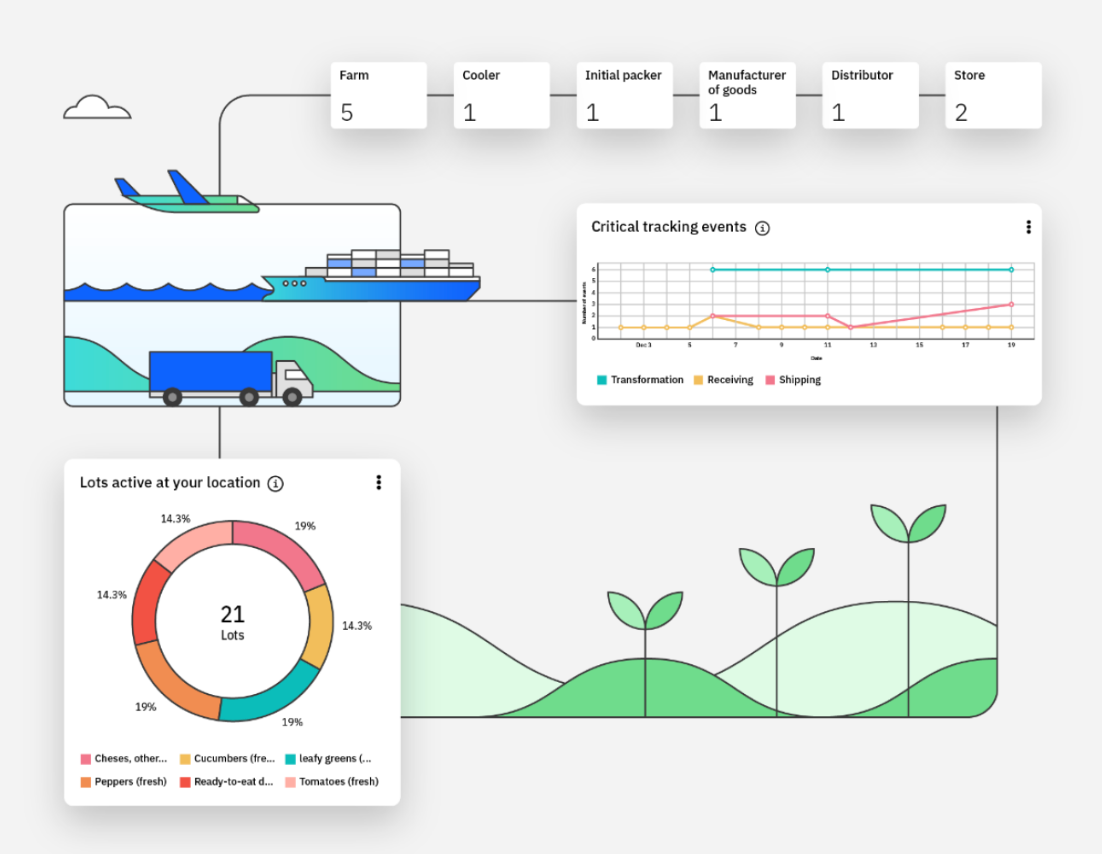
Ironclad is Ai Contract Management Software that helps draft, edit, negotiate, sign, and store contracts. This platform allows brands to handle a variety of different contract types, including legal, sales, finance, HR, marketing, procurement, and more.
Marketing and customer service
Artificial Intelligence (AI) can significantly enhance marketing and customer service for fashion brands by providing personalized experiences, automating routine tasks, and analyzing vast amounts of data to derive actionable insights.
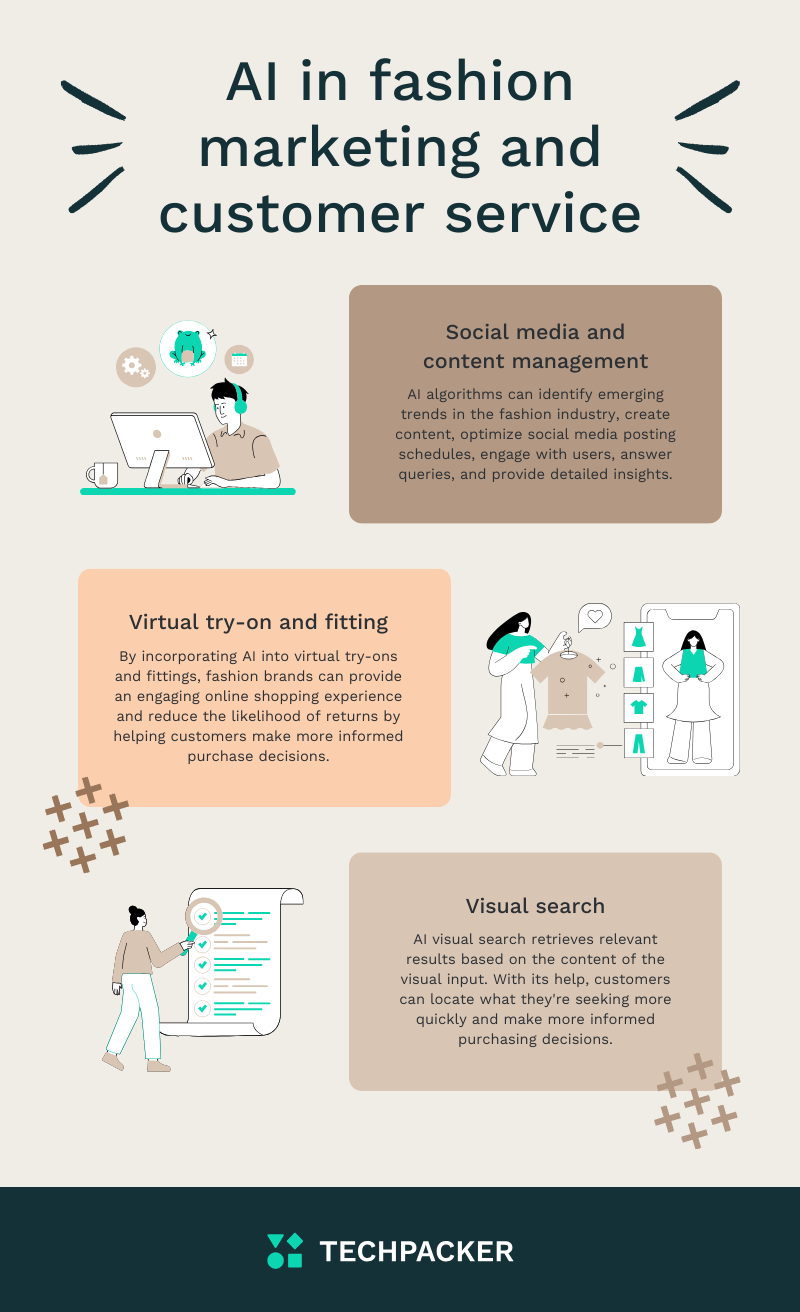
Social media and content management
Artificial Intelligence (AI) can significantly enhance the effectiveness of social media and influencer marketing strategies for fashion brands. Here are several ways AI can be applied to optimize these areas:
- Content Creation and Curation. AI tools can assist in generating and curating content for social media platforms. This includes creating engaging captions, suggesting hashtags, and even generating visually appealing images or videos.
- Social Listening. AI-powered social listening tools can monitor social media platforms for mentions of the brand, relevant hashtags, and industry trends. This helps fashion brands stay informed about customer sentiments and market trends.
- Trend Analysis. AI algorithms can analyze social media data to identify emerging trends in the fashion industry. This information is valuable for creating content that aligns with current consumer preferences.
- Automated Scheduling. AI-driven tools can optimize social media posting schedules based on when the target audience is most active. This ensures that content reaches a larger audience and generates more engagement.
- Chatbots for Engagement. Implement AI-powered chatbots on social media platforms to engage with users, answer queries, and provide information about products or promotions. This enhances customer interaction and satisfaction.
- Ad Targeting and Personalization. AI helps in precise ad targeting by analyzing user behavior and preferences. This ensures that social media advertisements are shown to the most relevant audience, increasing the chances of conversion.
- Performance Analytics. AI analytics tools can provide detailed insights into the performance of social media campaigns. This includes metrics such as engagement rates, click-through rates, and conversion rates, enabling data-driven decision-making.
- Chatbots for Engagement. Implement AI-powered chatbots on social media platforms to engage with users, answer queries, and provide information about products or promotions. This enhances customer interaction and satisfaction.
Pulsar AI technologies assist brands in identifying and analyzing current social media trends. Their clients have access to detailed and actionable insights that get to the heart of what matters most to their consumers, businesses, and society.
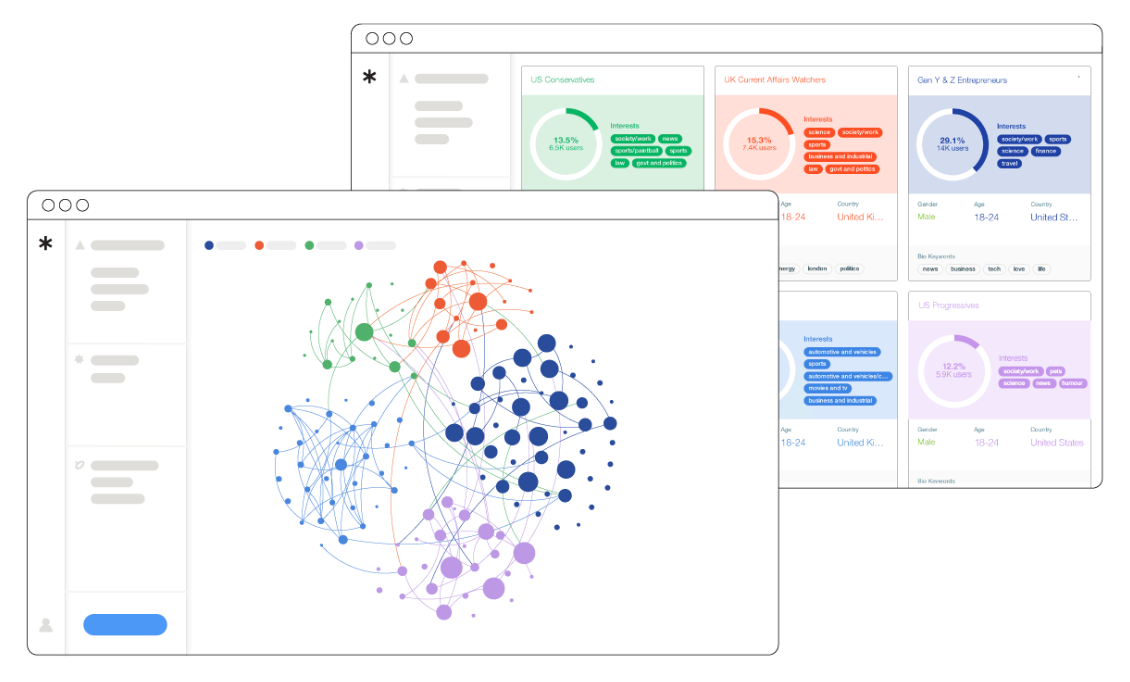
Braze is a customer engagement platform created as a software as a service (SaaS) to enable companies to build relevant and memorable experiences that encourage deeper consumer/brand connections. Braze enables users to create dynamic audiences and launch tailored customer journeys in minutes.
Anyword is a copywriting tool that helps create ads, social media, and blog posts. Simply enter your website and target consumer, and their copywriting machine will generate compelling content in minutes.
Virtual try-on and fitting
Artificial Intelligence (AI) plays a crucial role in enhancing virtual try-ons and fittings for fashion brands. By leveraging advanced algorithms and computer vision technologies, AI can create realistic and personalized virtual experiences for customers. By incorporating AI into virtual try-ons and fittings, fashion brands can not only provide an engaging and immersive online shopping experience but also reduce the likelihood of returns by helping customers make more informed purchase decisions.
Here are several ways AI contributes to virtual try-ons and fittings:
- Body Measurements and Analysis. AI algorithms can accurately measure and analyze body dimensions using images or videos uploaded by users.
- Virtual Fitting Rooms. Ai enables the creation of virtual fitting rooms where users can visualize how clothing items will look on their digital avatars.
- Clothing Simulation. AI can simulate the way fabrics and clothing items drape and move on the virtual avatar, providing a more realistic representation of how the actual garment would behave.
- Personalized Recommendations. By analyzing user preferences, purchase history, and style choices, AI can offer personalized product recommendations for virtual try-ons, increasing the likelihood of customer satisfaction.
- Face and Emotion Analysis. AI can analyze facial expressions and emotions during virtual try-ons to assess user reactions to different styles. This data can be used to refine recommendations and understand customer preferences better.
- Cross-Platform Integration. AI enables the integration of virtual try-on features across various platforms, including websites, mobile apps, and social media. This ensures a consistent and accessible experience for users.
Banuba is a platform for virtual try-ons. It uses a try-before-you-buy platform and an AI recommendation engine to help marketers increase sales, minimize returns, and enhance engagement.
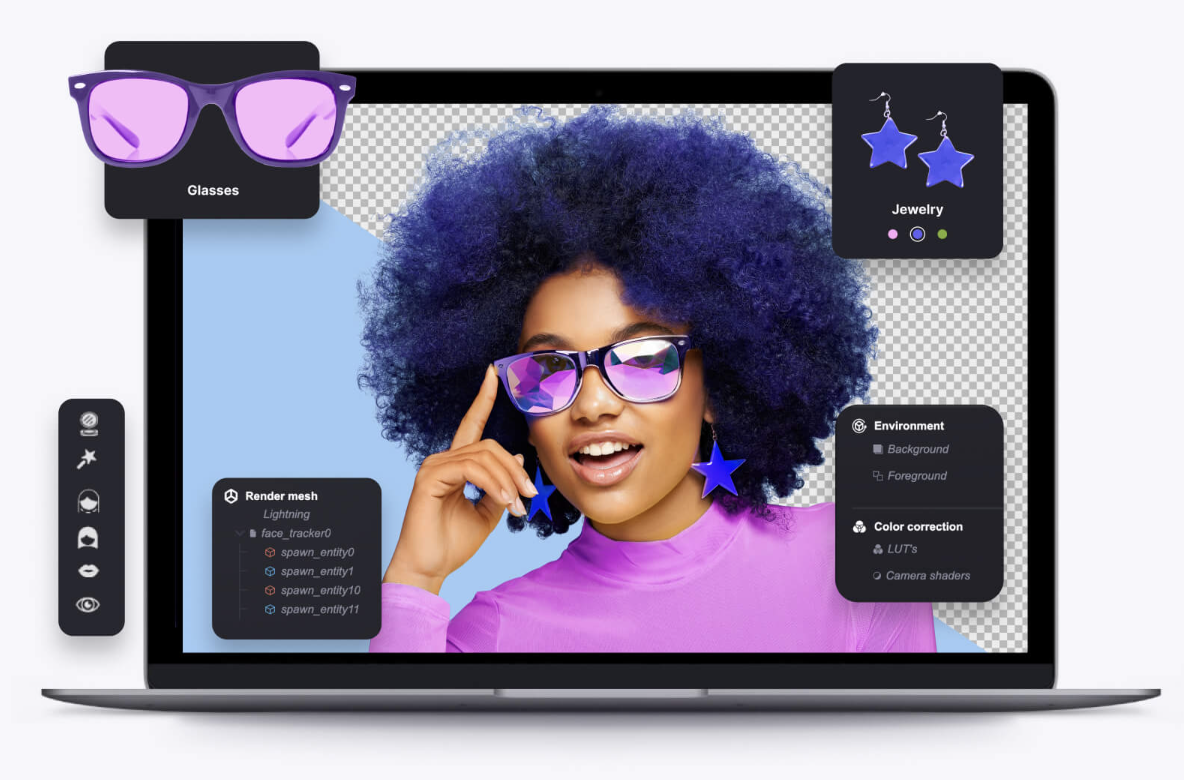
Google has introduced a generative AI virtual try-on tool. Shoppers may pick a model to digitally try on clothes from labels such as H&M, Loft, Everlane, and Anthropologie by clicking on goods with a "Try On" symbol. The technology will let customers see how the items would appear on persons ranging in size from XXS to 4XL, with various complexion tones, body shapes, and hairstyles.
Visual search
Visual search in AI refers to the capability of an artificial intelligence system to recognize and analyze visual information, such as images or videos, and retrieve relevant results based on the content of the visual input. Instead of using text-based queries, users can initiate searches by providing images as input, and the AI system identifies and returns similar or related visual content.
Key components and functionalities of visual search in AI include:
- Image Recognition. AI systems use advanced image recognition algorithms to analyze the visual features of an input image. This involves identifying patterns, shapes, colors, and other visual elements.
- Feature Extraction. The system extracts distinctive features from the input image, converting it into a numerical representation that the AI model can process and compare with other images.
- Similarity Scoring. The AI system assigns similarity scores to the retrieved results, indicating how closely they match the input image. This helps rank the results based on relevance.
- E-Commerce Applications. Visual search is widely employed in e-commerce platforms, allowing users to find products by taking pictures or uploading images. The system identifies the product or similar items, streamlining the shopping experience.
- Augmented Reality (AR) Integration. Visual search is often combined with AR technologies, allowing users to point their device's camera at real-world objects to receive information, reviews, or related content.
Canto is a digital asset management software that helps businesses all over the world optimize the value of their digital assets. Canto has capabilities such as facial recognition, version control, and asset collaborative procedures. Canto's easy interface design is one of its primary advantages, allowing users to simply search and filter through their digital assets.
Royal Cyber developed an AI-based visual search solution that allows clients to buy online as if they were in a real store. Customers may locate things quickly and shop for a full look.

Folio 3 is a visual search solution driven by AI. It may be used by fashion firms on their websites and apps to change the way their customers search for their items. Folio 3 is an AI-powered visual search solution that allows consumers to effortlessly search and locate items by leveraging photographs and images to connect real and digital experiences. Customers can locate what they're seeking more quickly and make more informed purchasing decisions.
Summary
In conclusion, the transformative impact of Artificial Intelligence on fashion product development is reshaping the industry's landscape, ushering in an era of unprecedented innovation and efficiency. From the initial stages of design through production and beyond, AI is proving to be a powerful ally, offering predictive insights, enhancing creativity, and optimizing processes.
As we navigate the intersection of technology and style, the symbiotic relationship between AI and fashion becomes increasingly evident. Designers are empowered to explore new frontiers, utilizing generative design tools to unlock once unimaginable possibilities. Virtual try-ons and fittings, powered by AI, provide consumers with immersive and personalized experiences, blurring the lines between the physical and digital realms.
Moreover, AI-driven trend analysis ensures that fashion brands stay ahead of the curve, aligning their offerings with evolving consumer preferences. The marriage of data analytics and creativity gives rise to a harmonious blend, where the artistry of design meets the precision of algorithms.
In the fast-paced fashion world, adaptability is key, and AI emerges as a catalyst for agility. Whether it's streamlining supply chain processes, optimizing pricing strategies, or revolutionizing marketing approaches, Artificial Intelligence serves as a driving force behind the industry's evolution.
As we look to the future, the synergy between human ingenuity and machine intelligence promises a dynamic and continuously evolving fashion landscape. The journey of AI in fashion product development is not just a technological revolution; it is a narrative of limitless possibilities and a testament to the boundless creativity that emerges when humanity embraces the tools of tomorrow. The runway of the future is illuminated by the fusion of fashion and AI, guiding us toward a new era where innovation knows no bounds.


